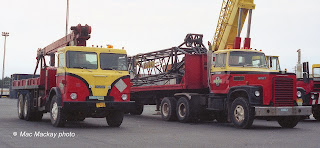Scot developed the C1 tilt cab (and its later variant the C2). Unlike the A1, the C series used a custom made steel cab, that was suitably low and quite wide to accommodate the "doghouse" that covered the engine.Engines to start with were Ford gas jobs, but diesels were also made available.
1. The factory sent this demo to a truck show in Halifax in 1975. It was normally used as a straight truck and rarely as a tractor.
2. One of the Irving companies, Industrial Services, operated a fleet of pumper trucks, such as this C1 seen in 1983.
3. Irving Oil ran a huge fleet of heating oil delivery trucks. There were both tandems and singles, with long and short wheelbases, and had the pump and hose reel mounted right behind the cab. 1983 photo.
4. Another Irving company was Speedy Propane. 1983 photo
5. This reconditioned C1 was operated by a Petro-Canada distributor-an Irving competitor. Without a refinery in Atlantic Canada, Petro-Canada no doubt bought a lot of their product from Irving Oil, so they were Irving customers too. Note the more usual rear mount pump and reel location.1984 photo
6. C1s set up as tractors were pretty rare, so this may have been a converted tanker. 1987 photo
7. By 1989 many C1s had worn out, but their tanker bodies were still in good shape. This airport re-fueling company bought new glider kits and grafted them onto the tanker bodies.
8. The AirConsol tank is finding a new home behind a Ford glider.
9. J.D.Irving Equipment had this C1 boom truck working in 1987, along with a fleet of A1s.
10. At some point the tilt cabs were given a larger grille, and the model designation was changed to C2. With a few modifications a standard fuel tanker, became a water tanker. The tire covers protect the rubber from prolonged exposure to ultra-violet light. 1985 photo
10. At some point the tilt cabs were given a larger grille, and the model designation was changed to C2. With a few modifications a standard fuel tanker, became a water tanker. The tire covers protect the rubber from prolonged exposure to ultra-violet light. 1985 photo
11. Scot built these C2 yard goats for the shipping company Fednav and its subsidiary Atlantic SeaRoute Ltd. They hauled container trailers off an on board ships in Halifax harbour. The large grille (and rad) were needed for cooling, but also improved the appearance of the truck 1984 photo
12. At least one of the C2s lasted until 1990 as a fuel bowser. It sits here with the unusual Plan (which is still in service in 2013) Note the front mount muffler and exhaust.
13. This is a typical C1 aircraft fueler, one of the large markets for Scot. By the time this photo was taken it had been retired, but appeared to be in virtually original condition.
14. In 1981 A C2 fuel tanker has found a second career as a pumper/tank for a cleaning company.
.
13. This is a typical C1 aircraft fueler, one of the large markets for Scot. By the time this photo was taken it had been retired, but appeared to be in virtually original condition.
14. In 1981 A C2 fuel tanker has found a second career as a pumper/tank for a cleaning company.
The C1 cab was also used for fire apparatus, but that is another story - to be posted soon.















There is a Scot Model C sitting in a yard in Edmonton with a small integral bunk. 6-71 power and a.gravel box.
ReplyDelete